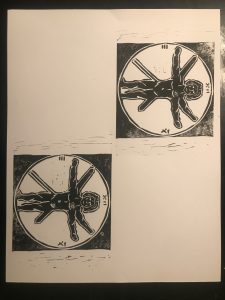I chose to do my STEAM project on circadian rhythms, and specifically their effect on athletic performance. The artwork I made doesn’t necessarily represent the athletic performance aspect, but it is representational of our body’s internal clocks. I made a version of Da Vinci’s “Vitruvian Man” but instead of having 8 normal limbs 3 of them are replaced with the hour, minute, and second hand of a clock. The medium I chose for my project is a linoleum block print.




Parker made this year’s project about the Pineal Gland, Circadian Rhythm, and Athletic Performance. He starts by introducing the pineal gland as one of the most important endocrine glands in our body. This gland can also be known as a third eye. Parker explains, “The pineal gland is called the third eye due to its reactivity to light via the suprachiasmatic nucleus (SCN). The SCN is a specific region within the hypothalamus that receives neural signals from the optic nerve about the presence of light. From there, neurons in the SCN then signals the pineal gland to either stop or start the production and release of melatonin.” Following, he provides why circadian rhythms are crucial in regulating body temperature, blood pressure levels, various hormones, occasionally growth hormones, and other bodily functions. Commonly, jet lag is known to disrupt the circadian rhythm and our zeitgeber. Parker describes how “the daily light input that keeps our circadian rhythm in line is known as a zeitgeber.” Jet lag can be known to happen throughout short times over long distances. Due to this, our body’s internal clocks may be several hours off from the 24 hour light schedule of the place you have just traveled. The disconnect linking our internal clock and the physical world can harm physical and mental performance. Usually, within normal functioning bodies, the athletic performance and circadian rhythm are found to be the highest around the late afternoon or early evening. As a result, it is guessed that this is because the early evening is additionally our peak body temperature. For Parker’s artwork for his steam project, he decided to go for a “rendition of the Vitruvian Man by Da Vinci.” Parker’s twist on this project includes three of the man’s eight limbs and replaces it for the hour, minute, and second hand of the clock. He also describes a clock in the background, I can vividly see it, but I can understand the concept he was going for. Parker ends his design with a unique meaning behind his project. He says, “The piece represents how our bodies are just big biological clocks controlled by circadian rhythms.”